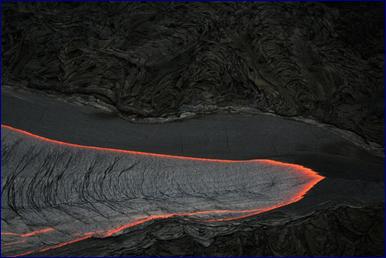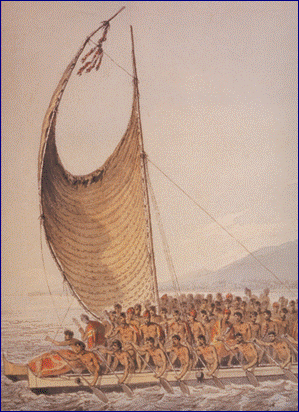XII. Hatching Plans
either log in or click here to purchase.
Log in here to access video.
Haven't purchased Eye of the Storm Leadership?
Starting Point / Seeing Tahiti
Located twenty degrees north of the equator in the center of the Pacific Ocean, Hawaii is the most geographically-isolated place in the world. It is more than two thousand, five hundred miles from the nearest major landmass and was one of the last places on earth to be discovered and populated. At a time when Europeans cleaved close to their coasts for fear of falling off the edge of the world and being gobbled up by sea monsters, Polynesians were crisscrossing the Pacific on epic voyages of discovery and colonization.
The Polynesians came to Hawaii in two waves, the first from the Marquesas  approximately 500 AD, the second from Tahiti a thousand years later. For a time, there were voyages back-and-forth over the equator. Then, the technologies and lore of open-ocean voyaging were forgotten. But not the memory of them.
 Lava Flow, Island of Hawai. Credit: Wikimedia Commons
Lava Flow, Island of Hawai. Credit: Wikimedia CommonsThe intrepid canoe builders turned to a man named Mau Piailug, a navigator from Satawal Island in the Carolines of Micronesia. They asked him for two things: help them make the initial voyage from Hawaii to Tahiti, and teach a new generation of smart and passionate Hawaiians how to sail by the stars, swells, sun, moon, and the taste of seawater in different parts of the Pacific. More than a dozen young Hawaiians, all skilled watermen, were tutored by Mau, among them Nainoa Thompson, the man who would eventually become one of Hokule‘a’s first Hawaiian navigators.
Nainoa tells the story of his tutoring with Mau Piailug this way.
“One day after months of training, Mau asked me to join him early one morning at a place called Lanai Lookout. From that place on the eastern side of Oahu you can see at least two and sometimes even three other islands if the weather is good: Molokai, Maui, and Lanai. It is also near a channel called Kealaikahiki which means `The Road to Tahiti.’ Standing there in the sunrise, Mau asked me some odd questions.
First he asked me how I felt. I told him I was nervous but happy with all that I was learning. He smiled and then a little while later he asked me to point to Tahiti, which I did. Finally, after a time, he said: ‘ Nainoa, can you see Tahiti?’
 Hawaiian Canoe by James Webber, Artist on Captain Cook’s Expedition. Credit: Wikimedia Commons.
Hawaiian Canoe by James Webber, Artist on Captain Cook’s Expedition. Credit: Wikimedia Commons.A few days later, Nainoa and his crew left for Tahiti and successfully completed the first such voyage in more than a thousand years.[i]
That first voyage of the Hokule‘a, along with subsequent ocean journeys to other corners of the Polynesian Triangle -- the Marquesas, New Zealand, and Easter Island -- had significant ripple effects. In fact, it put in train a “Hawaiian Renaissance,� a cultural revival of dance, chant, carving, song-making, lei-making, and language study. It also launched a political movement. Influenced by the civil rights struggles of Blacks, Hispanics, and Native Americans, Hawaiians gained new confidence and pride in confronting their own disenfranchisement. Seeing the billions of dollars and forty million acres of land that had been awarded to native Alaskans, they pressed for reparations and sovereignty measures in Congress.
Oceans are the primordial soup and perpetual incubators of life. Plants, animals, and ideas move around, combine, re-circulate, and ultimately splice off to create new species. Not all survive but evolution tends to produce remarkable and enduring results. Around the states and nations of the Pacific, in Polynesia, Micronesia, and Melanesia, many cultures are resurgent with pride and enthusiasm. Old languages are being revitalized, the arts are flourishing, and politics engaged in new ways. Meanwhile, like some kind of waterborne bumblebee, the Hokule‘a continues to visit the islands and atolls of the Pacific carrying scholars, school children, inter-island messages, and great hope. It is a pollinator leaving behind in its wake a future that holds more than it used to.

111Â Â Imperfection
“The shortest distance between two points is under construction.� Noelie Altito
 2006 Coup in Thailand. Credit: Wikimedia Commons.
2006 Coup in Thailand. Credit: Wikimedia Commons.
112Â Â Schemes
“Thinking big, thinking differently. Seeing around corners – and into the future. Painting a picture of a better tomorrow – and helping people get there. This sometimes unwieldy process takes a lot of care.� Shelby Coffey III
|
|
This site managed with Dynamic Website Technology
from Mediate.com Products and Services |
